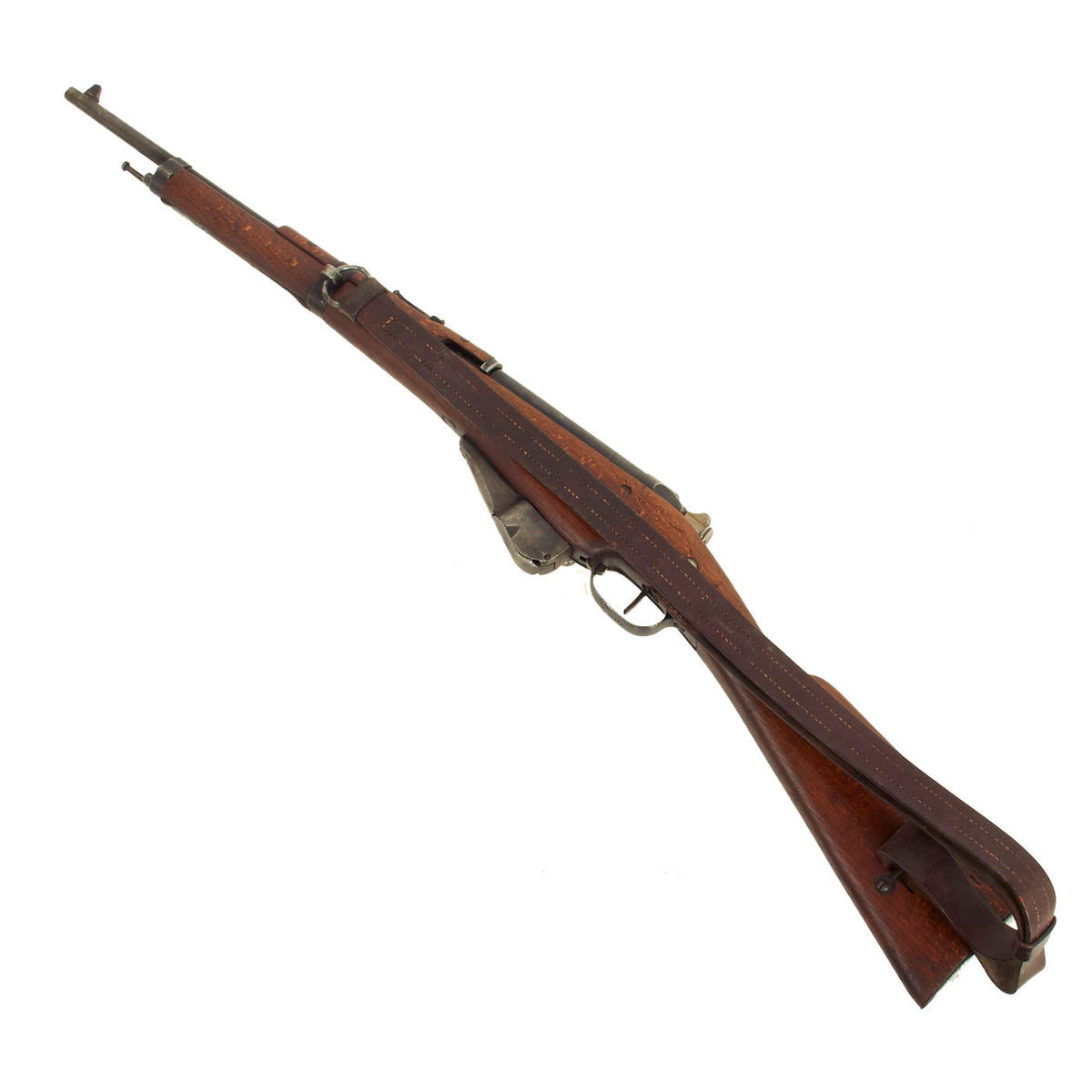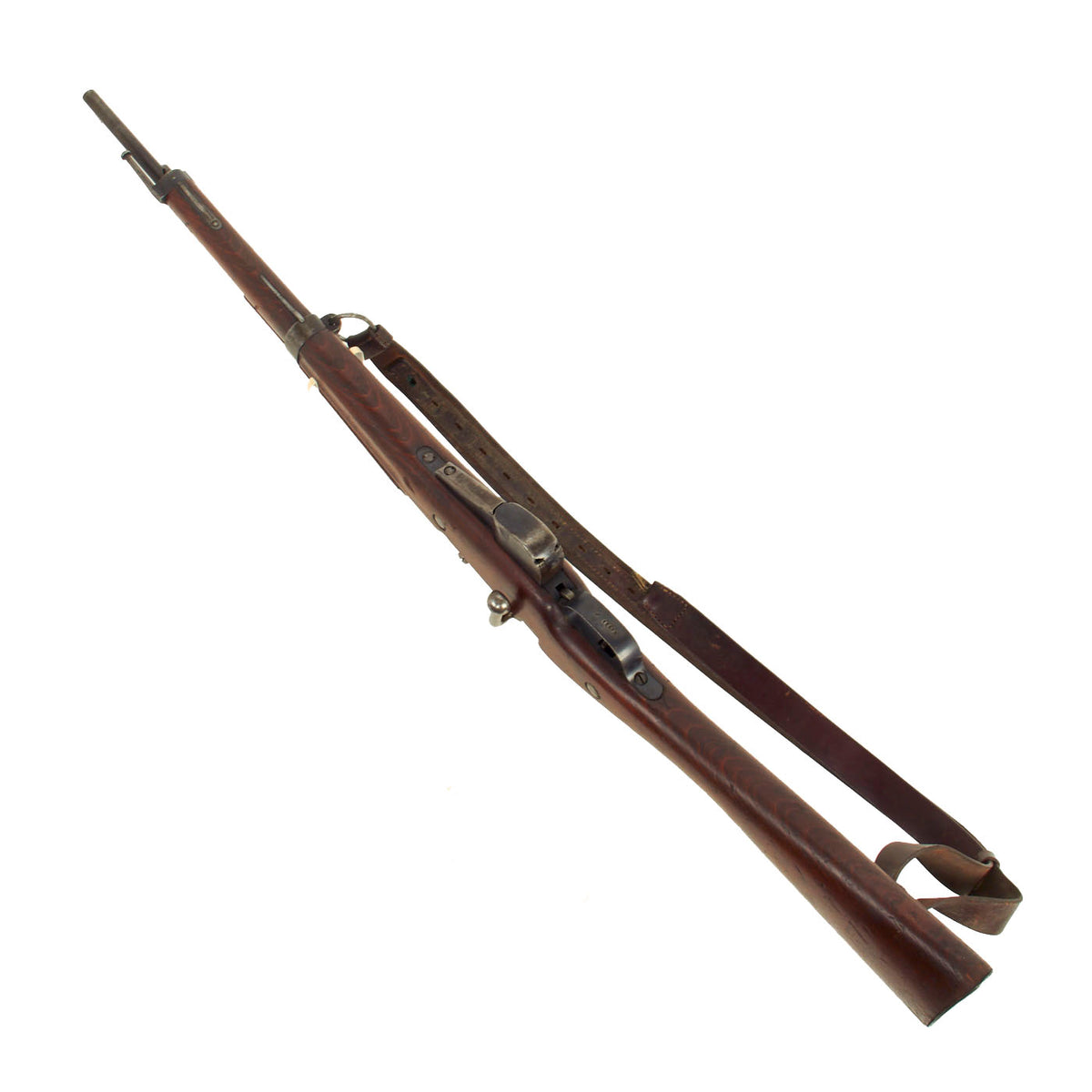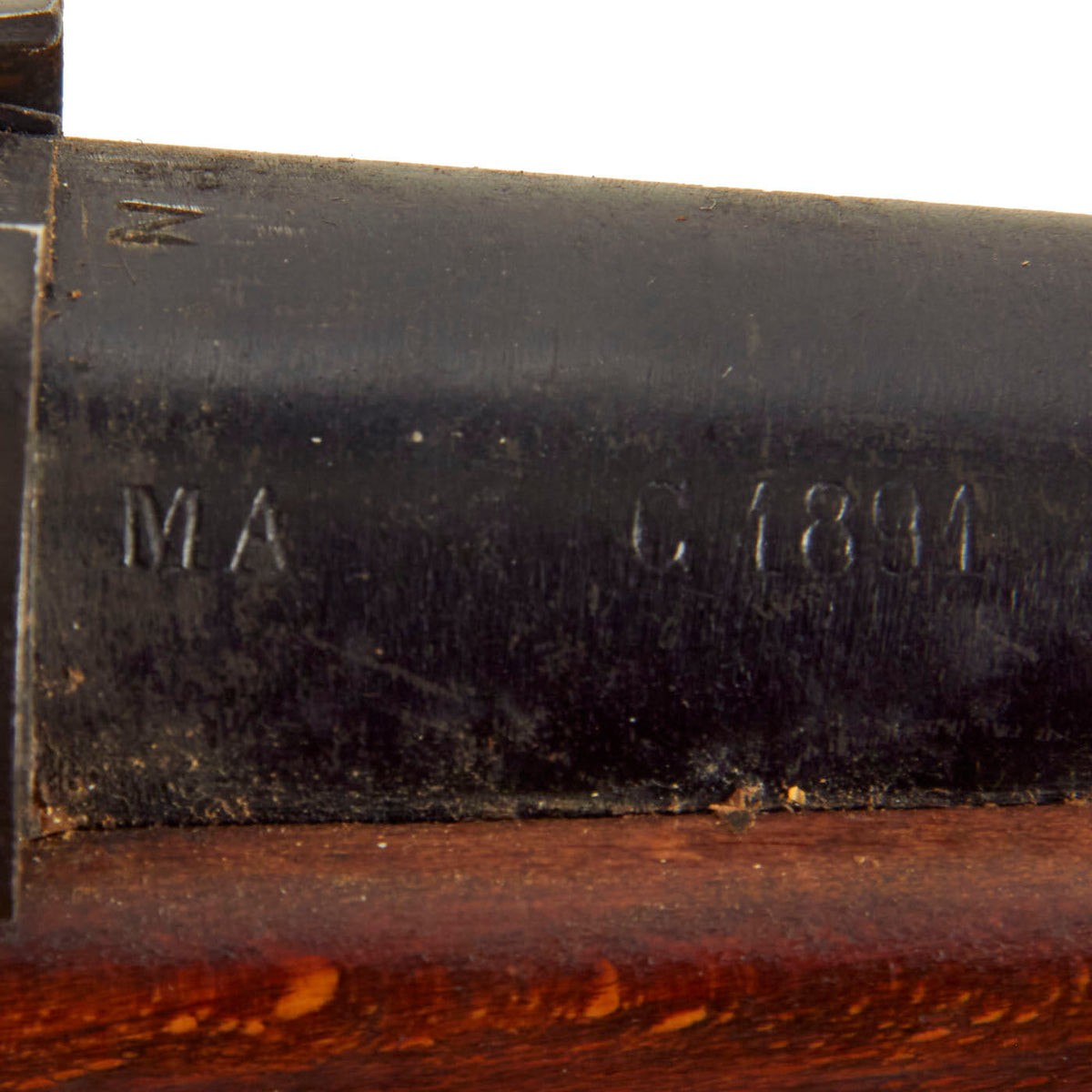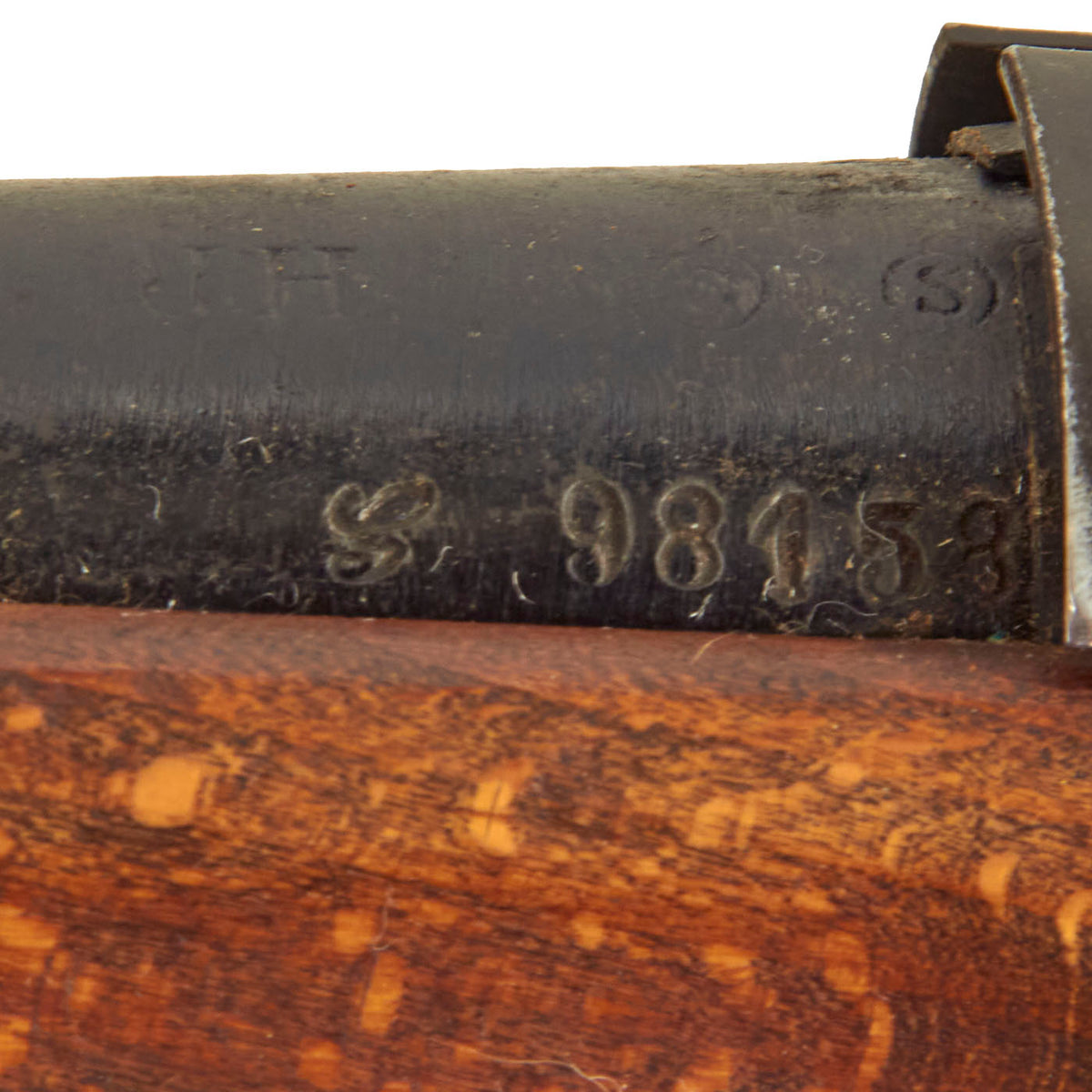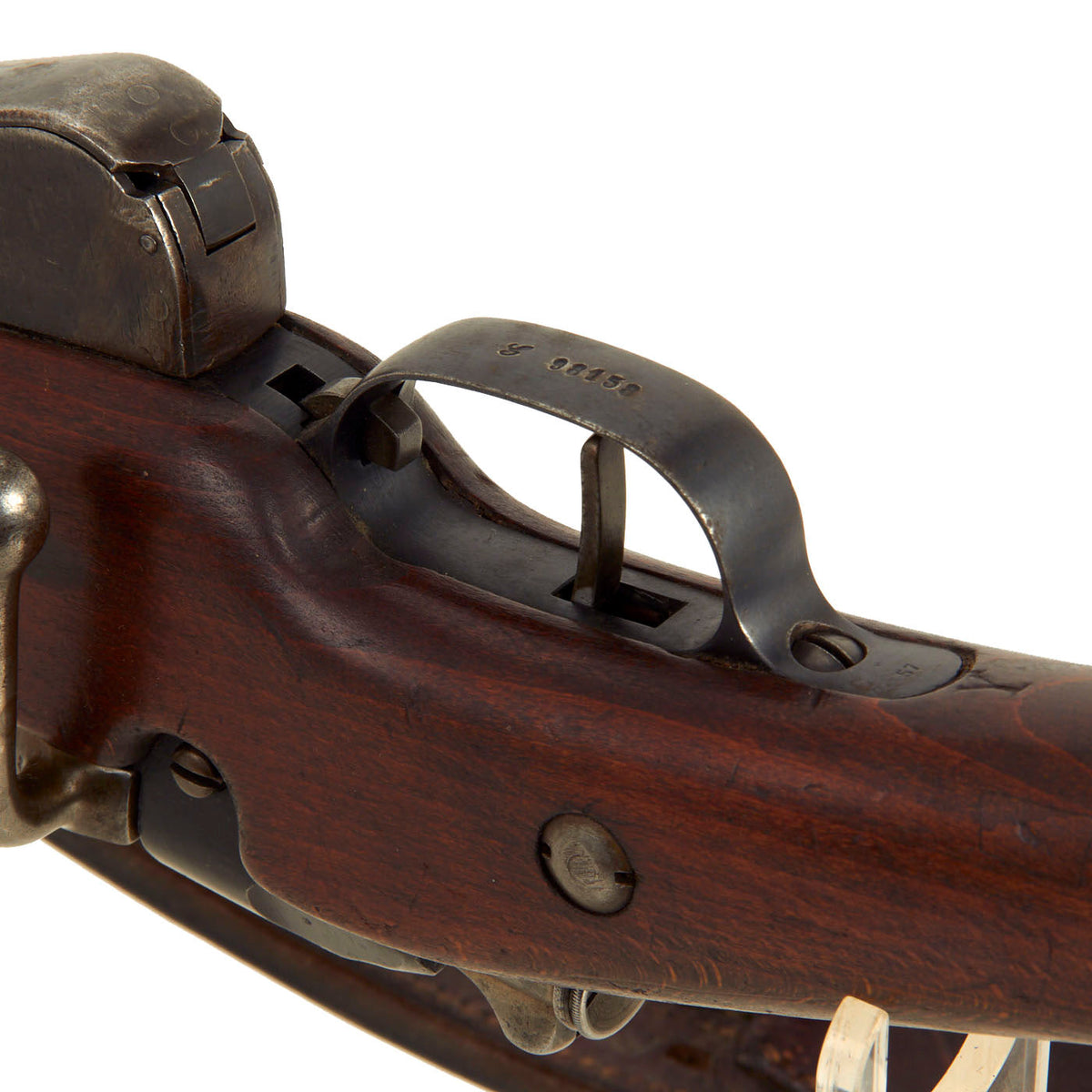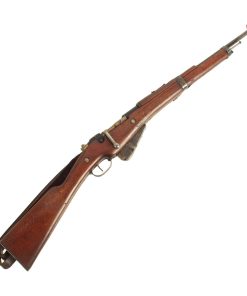Original French Mannlicher Berthier Mle 1890 M16 Converted Saddle-Ring Carbine by Châtellerault Serial G98158 with Sling – dated 1891 Original Items
$ 1.095,00 $ 273,75
Original Item: Only One Available. The Mannlicher-Berthier rifles and carbines were a family of bolt-action small arms in 8mm Lebel, used in the French Army from the 1890s to the beginning of World War II (1940).
The Berthier design began as the “Mousquetons Berthier” – a series of bolt-action cavalry and artillery carbines with distinctly different actions from the Mle 1886/M93 8mm Lebel rifle. For instance, the Berthier carbine’s bolt lugs lock vertically into the receiver instead of horizontally as in the Lebel rifle. Berthier carbines were first issued in 1890 and 1892, and had been designed by Emile Berthier, an engineer at the French Algerian Railways,to be used with standard 8mm Lebel ammunition.
The Berthier design was introduced as a replacement for the various aging Mle 1874 Gras single-shot carbines – still standard for French cavalry, artillery, and gendarme forces even after the introduction of the Mle 1886/M93 Lebel. Prior experiments with several carbine versions of the Lebel action proved unacceptably heavy and slow to load while on horseback. While retaining most of the action’s strong points, the Berthier carbine improved on the earlier Mle 1886 rifle by using a one-piece stock and a Mannlicher-style, charger-loaded en bloc 3 shot clip. These Berthier carbines were progressively allocated to all cavalry, artillery and gendarmerie troops during the 1890s.
The first Berthier carbine came into production as the “Carabine de Cavalerie Modèle 1890”, which was officially adopted for service on March 14, 1890. The main production facilities were the Manufacture d’Armes de St Etienne or MAS and the Manufacture d’Armes de Chatellerault or MAC. The search for a suitable small arm for mounted troops was given greater urgency by the Germans’ development of the Karabiner Modell 1888, a carbine variant of the Gewehr 1888. It was issued to essentially all French artillery and cavalry troops. As the high Command appreciated the performance of the Mle 1890 Berthier carbine, a second version was specifically produced for artillery service, the “Mousqueton Mle 1892” which could mount a short blade bayonet and thus had a re-designed forend stock. However it continued to feature the 3-round En-bloc clip of the Model 1890 carbine.
During the First World War it became obvious that the 3-round clip was a handicap compared to German short weapons such as the German Kar98AZ which had a 5-round clip. Additionally, it was found that trench mud and grit could enter the weapon through the opening in the bottom of the magazine. To correct these issues, the Model 1916 Berthier rifle was introduced with a five-round en-bloc clip. The clip discharge opening at the bottom of the protruding magazine was replaced by a spring loaded trapdoor to keep out dirt and debris. This improved 5-shot design was then fitted to existing rifle and carbine-length Berthier models (Mle 1907/15, Mle 1890M16, 1892M16 and Mle 1916 “mousquetons” )
This is one such Mle 1890 Carbine that was updated during WWI to the M16 standard, and had the markings on the left side of the receiver removed, and now only reads M16. It was also modified so that it would now be able to fit a bayonet. The rifle has arsenal proofs on most parts, and also is marked MA C 1891, the abbreviation for Manufacture d’Armes Châtellerault, indicating that it was produced in 1891, the second year of production for the Mle 1890 Carbine. The carbine has serial number G 98158 on the barrel, bolt, stock and trigger guard, making this a “PARTIALLY MATCHING” example. The carbine is fitted with a large Saddle Ring on the left side of the 17″ barrel, and has no provision for a cleaning rod. It also has what looks to be an interwar leather sling fitted to the ring and stock.
This Berthier Saddle Ring carbine is in very good condition, with typical wear from years of service. It cycles and dry fires well, though we have no way to verify that the magazine will feed correctly. The rear sight is still intact, and fully functional. The bore is in very good condition, with a bright finish showing clear lands and grooves. There is just a bit of rounding on the lands, so it did see some level of use while in service, but not a lot. Metal components show the arsenal refinishing well, with the original bright bolt having some gray on the exposed areas. The stock is in very nice condition with a great color and grain. There is a faded arsenal cartouche on the right side of the butt stock.
A very nice example of a hard to find carbine in very good shape, ready to display!
Specifications-
Year of Manufacture: 1891
Caliber: 8×50mmR Lebel
Cartridge Type: Centerfire Cartridge
Barrel Length: 17 Inches
Overall Length: 37 Inches
Action type: Bolt-Action
Feed System: 5-round Mannlicher-style en-bloc clip
Fast Shipping with Professional Packaging
Thanks to our longstanding association with UPS FedEx DHL, and other major international carriers, we are able to provide a range of shipping options. Our warehouse staff is expertly trained and will wrap your products according to our exact and precise specifications. Prior to shipping, your goods will be thoroughly examined and securely secured. We ship to thousands clients each day across multiple countries. This shows how we're dedicated to be the largest retailer on the internet. Warehouses and distribution centres can be located throughout Europe as well as the USA.
Note: Orders with more than one item will be assigned a processing date depending on the item.
Before shipping before shipping, we'll conduct a thorough inspection of the items you have ordered. Today, the majority of orders will be delivered within 48 hours. The delivery time will be between 3-7 days.
Returns
The stock is dynamic and we cannot completely manage it because multiple stakeholders are involved, including our factory and warehouse. So the actual stock may alter at any time. It's possible that you may not receive your order once the order has been made.
Our policy is valid for a period of 30 days. If you don't receive the product within 30 days, we are not able to issue a refund or an exchange.
You can only return an item if it is unused and in the same state as the day you received it. You must have the item in its original packaging.
Related products
Uncategorized
Uncategorized
Uncategorized
Uncategorized
Australian WWII Owen MK1 Machine Carbine SMG Custom Fabricated Replica with Sling Original Items
Uncategorized
Uncategorized
Uncategorized
Uncategorized
Uncategorized
Uncategorized
Uncategorized
Uncategorized
Uncategorized
Armoured Fighting Vehicles of the World: AFVs of World War One (Hardcover Book) New Made Items
Uncategorized
Uncategorized
Uncategorized
Uncategorized
Uncategorized
Angolan Rebel 1970s era 60mm Inert Display Mortar from Angolan Civil War Original Items
Uncategorized
Uncategorized

